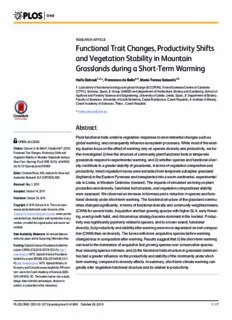
Functional Trait Changes, Productivity Shifts and Vegetation Stability in Mountain Grasslands PDF
Preview Functional Trait Changes, Productivity Shifts and Vegetation Stability in Mountain Grasslands
RESEARCHARTICLE Functional Trait Changes, Productivity Shifts and Vegetation Stability in Mountain Grasslands during a Short-Term Warming HaifaDebouk1,2*,FrancescodeBello3,4,Maria-TeresaSebastià1,2 1 Laboratoryoffunctionalecologyandglobalchange(ECOFUN),ForestSciencesCentreofCatalonia (CTFC),Solsona,Spain,2 GroupGAMESanddepartmentofHorticulture,BotanyandGardening,Schoolof AgrifoodandForestryScienceandEngineering,UniversityofLleida,Lleida,Spain,3 DepartmentofBotany, FacultyofSciences,UniversityofSouthBohemia,ČeskéBudějovice,CzechRepublic,4 InstituteofBotany, CzechAcademyofSciences,Třeboň,CzechRepublic a11111 *[email protected] Abstract Plantfunctionaltraitsunderlievegetationresponsestoenvironmentalchangessuchas OPENACCESS globalwarming,andconsequentlyinfluenceecosystemprocesses.Whilemostoftheexist- Citation:DeboukH,deBelloF,SebastiàM-T(2015) ingstudiesfocusontheeffectofwarmingonlyonspeciesdiversityandproductivity,wefur- FunctionalTraitChanges,ProductivityShiftsand therinvestigated(i)howthestructureofcommunityplantfunctionaltraitsintemperate VegetationStabilityinMountainGrasslandsduringa grasslandsrespondtoexperimentalwarming,and(ii)whetherspeciesandfunctionaldiver- Short-TermWarming.PLoSONE10(10):e0141899. doi:10.1371/journal.pone.0141899 sitycontributetoagreaterstabilityofgrasslands,intermsofvegetationcompositionand productivity.Intactvegetationturveswereextractedfromtemperatesubalpinegrassland Editor:ChristianRixen,WSLInstituteforSnowand AvalancheResearchSLF,SWITZERLAND (highland)intheEasternPyreneesandtransplantedintoawarmcontinental,experimental siteinLleida,inWesternCatalonia(lowland).Theimpactsofsimulatedwarmingonplant Received:May1,2015 productionanddiversity,functionaltraitstructure,andvegetationcompositionalstability Accepted:October14,2015 wereassessed.Weobservedanincreaseinbiomassandareductioninspeciesandfunc- Published:October29,2015 tionaldiversityundershort-termwarming.Thefunctionalstructureofthegrasslandcommu- Copyright:©2015Debouketal.Thisisanopen nitieschangedsignificantly,intermsoffunctionaldiversityandcommunity-weightedmeans accessarticledistributedunderthetermsofthe (CWM)forseveraltraits.Acquisitiveandfast-growingspecieswithhigherSLA,earlyflower- CreativeCommonsAttributionLicense,whichpermits ing,erectgrowthhabit,andrhizomatousstrategybecamedominantinthelowland.Produc- unrestricteduse,distribution,andreproductioninany medium,providedtheoriginalauthorandsourceare tivitywassignificantlypositivelyrelatedtospecies,andtoalowerextent,functional credited. diversity,butproductivityandstabilityafterwarmingweremoredependentontraitcomposi- DataAvailabilityStatement:Allrelevantdataare tion(CWM)thanondiversity.Theturveswithmoreacquisitivespeciesbeforewarming withinthepaperanditsSupportingInformationfiles. changedlessincompositionafterwarming.Resultssuggestthat(i)theshort-termwarming Funding:SpanishScienceFoundationfundedthe canleadtothedominanceofacquisitivefastgrowingspeciesoverconservativespecies, projectCAPAS(CGL2010-22378-C03-01),http:// thusreducingspeciesrichness,and(ii)thefunctionaltraitsstructureingrasslandcommuni- www.fecyt.es/:MTS.SpanishScienceFoundation tieshadagreaterinfluenceontheproductivityandstabilityofthecommunityundershort- fundedtheprojectBIOGEI(CGL2013-49142-C2-1- termwarming,comparedtodiversityeffects.Insummary,short-termclimatewarmingcan R),http://www.fecyt.es/:MTS.SpanishMinistryof EconomyandCompetitivenessfundedtheFPIshort- greatlyaltervegetationfunctionalstructureanditsrelationtoproductivity. termvisittotheCzechAcademyofSciences(BES- 2011-047009):HD.Thefundershadnoroleinstudy design,datacollectionandanalysis,decisionto publish,orpreparationofthemanuscript. PLOSONE|DOI:10.1371/journal.pone.0141899 October29,2015 1/17 FunctionalChangesinMountainGrasslandsunderWarming CompetingInterests:Theauthorshavedeclared Introduction thatnocompetinginterestsexist. Highmountainecosystemsareconsideredtobeparticularlyvulnerabletoglobalwarming [1,2].Underclimatechangeconditions,floristicbiodiversityinEuropeansemi-natural,spe- cies-richandsubalpinegrasslandsisexpectedtobehighlyaffected[3–5].Anumberofstudies haveobservedthatwarmingenhancesproductivity[6–10],altersspeciescompositionand reducesspeciesdiversity[10,11],atleastinashortterm.Theincreaseinbiomassproductivity hasbeenattributedtotheenhancedplantgrowthasatransientresultofincreasedsoilorganic mattermineralization[12,13]andnutrientavailabilitywithwarming[6,8].Theseresource enrichedenvironmentalconditionsareconsideredfavorabletospeciescharacterizedbyfast growthandhighreturnsonresourcesinvestment[14,15].Thismeansthatconservativespe- cies,withslowernutrientacquisitionandslowergrowth(asopposedtoacquisitivespecies, Diazetal.[16])couldbeout-competedasaresultofnutrientdepletionbyfast-growingspecies [17]orcoulddisappearasaresultoflowadaptationabilitytothenewconditions.Increased productivitycan,therefore,eitherincreaseorreducediversitydependingontherelationship betweenproductivityanddiversity[18,19]. Theimpactofwarmingshouldalsodependontheresistanceandresilience,altogether definingstability,ofplantcommunities.Inmanystudies,thestabilityofthecommunityhas beenrelatedtodiversity—withanaprioriknownasthe“diversitybegetsstability”hypothesis. Thetheorysuggestsapositivestability-diversityrelationshipbecausethesystemcouldbemore stablewhenmorespeciesareavailable,thusprovidingasortofinsurancetowardsdifferent environmentalchanges[20–23].However,otherstudiesquestionthishypothesis[24–26] becauseecosystemstabilitycouldsimplydependonthetypeofdominantspeciesinthesystem. Thesestudiesadvocatethatthepositivecorrelationbetweenstabilityanddiversitycanbe explainedbythefactthathigherdiversitysimplyincreasestheprobabilityofincludingspecies withtraitsbetteradaptedtothenewenvironmentalconditions[27–29].Theyalsoarguethat lookingonlyatspeciescompositionanddiversitydoesnotgiveamechanisticviewontheeco- systemanddoesnotallowgeneralizationsbeyondspecificsites. Whileseveralstudieshaveassessedtheeffectofglobalwarmingonspeciesdiversity[3– 5,30,31],theresponseofthecommunityplantfunctionaltraitstoincreasingtemperaturesand theirroleinthevegetationstabilityhavebeengenerallyoverlooked.Theimportanceofplant functionaltraits(anycharacteristicsoforganismswhichimpactitsfitness)liesinthefactthat theyconsistentlyrevealcommunityresponsestoenvironmentalchangesacrossregionsand controlecosystemprocesses(vegetativegrowth,photosynthesis,decomposition,etc.[32]).Spe- cieswithdistinctfunctionaltraitsareexpectedtoresponddifferentlytoenvironmentalcondi- tions,andhenceinfluenceecosystemprocessesaccordingly[33].Inwarmingexperiments,it remainsunclearhowdiversityandplantfunctionaltraitsinfluencethecommunityresistance andtowhichextenttheycontributetoitsresilienceunderwarming.Itisalsounclearhoweco- systemprocessessuchasproductivityandstabilitywillbeaffectedbychangesinvegetation structureandwhattypeofspecieswillbecomemoredominant.Therefore,weexpectthatthe studyoffunctionaltraitscanimproveourunderstandingofthemechanismsrelatedtothesta- bilityoftheecosystem,underwarming. Inthisstudy,weinvestigatedtheeffectofwarmingonproductivity,planttraitscomposition andfunctionaldiversityduringonegrowingseasonthroughtransplantinggrasslandturves fromthehighland(humidandcold)tothelowland(dryandwarm)areas.Wefocusonsemi- naturalsubalpinegrasslandsintheEasternPyrenees,whichareconsideredtobevulnerableto climatechangeduetotheirpositionatthesouth-westernedgeofthesemi-naturalgrassland biomeinEurope[8].Additionally,climatechangescenariosintheregionpredictanincrease inmeanannualtemperatureof0.5°Candadecreaseinmeanannualprecipitationof10%[34]. PLOSONE|DOI:10.1371/journal.pone.0141899 October29,2015 2/17 FunctionalChangesinMountainGrasslandsunderWarming ParticularlyintheSpanishPyrenees,effectsofwarmingarebelievedtobeparticularlypro- nounced[35,36].Manystudiessuggestthatbiodiversityenhancesecosystemfunction[37,38] andisindispensableforthestabilityofplantcommunitiesintermsofproductivityandvegeta- tioncomposition[20–22].Howeverstabilitydoesnotonlydependonspeciesrichnessbutalso onthefunctionaltraitsofthespeciesandonthegrowth-relatedtraits[25,26].Therefore,we hypothesizethatcommunitytraitsassociatedtoresourceacquisitionandcompetitiveness(spe- cificleafarea,leafdrymattercontent,startoffirstflowering,plantheight,growthhabit,rhi- zome-formation,etc.),togetherwithspeciesrichness,willcontributetothestabilityofthe communityinthefaceofwarming,intermsofvegetationcomposition.Wealsohypothesize thattheincreasedproductivityinthelowlandisnotexclusivelytheresultoftheinitialspecies richness,butalsoofthefunctionaltraitchangesunderwarmingconditions.Inourstudy,we analyze(1)theresistanceofthegrasslandcommunitytowarming,(2)theeffectofdiversity andfunctionaltraitsonbiomassproduction,(3)andtheeffectofspeciesandfunctionaldiver- sityandfunctionaltraitscompositiononcommunitystabilityintermsofvegetation composition. MaterialsandMethods Transplanting Ashort-term(onegrowingseason)climatechangeexperimentwascarriedoutthroughtrans- plantinggrasslandturvesfromhighland(moistandcold)tolowland(dryandwarm)areas. Thehighlandstudysystemconsistedoftwocoldtemperatesemi-naturalsubalpinegrassland sites(p1andp2)ataround2000ma.s.l.withadistanceofapproximately1kmfromone anotheratthePladeRusinCadí-MoixeròNaturalPark(1(cid:1)993°E,42(cid:1)276°N).Thesesubalpine grasslandsarecharacterizedbycoldtemperateclimate(meanannualtemperatureis5.3°Cand meanannualprecipitationis1183.4mm;AtlasClimàticDigitaldeCatalunyahttp://www. opengis.uab.cat/acdc/,accessedinJuly2013).Thevegetationwasdominated,inbothsites,by subalpineperennialmesicgrasslandsonlimestonedominatedbyFestucanigrescensLam.,in additiontoCarexcaryophylleaLatourr.,AnthoxanthumodoratumL.,Potentillaneumanniana Reichenb.,GaliumverumL.,ThymuspulegioidesL.,andKoeleriamacrantha(Ledeb.)Schultes (seeSebastiáetal.[7]formoredetailsonoriginalvegetationandenvironment). Theexperimentaddressedmostlyatemperatureandwaterchangescenario(seebelow)dur- ingthevegetativeperiodoftheplants,representinganextremewarmingevent.Ateachofthe twohighlandsites,60turveswereextractedandeachturfwasputinplastictraysof40cmx40 cmx20cm(depth).Halfoftheturvesfromeachsitewereselectedrandomlyandplacedback inthegrassland(‘highland’treatment).Theotherhalfwasplacedinexperimentalfieldsofthe SchoolofAgrifoodandForestryScienceandEngineeringoftheUniversityofLleida(‘low- land’).ThelowlandsitehasacontinentalMediterraneanclimate(meanannualtemperatureis 14.5°Candmeanannualprecipitationis442mm).Sincethelowlandsite(Lleida)isexposedto verydryandwarmconditionsduringsummer,waterwasaddedweeklytoapproximatehalfof thenaturalrainfrequencyatthesubalpinesiteandtopreventthemortalityoftheplantsdueto thehighdiscrepancyinprecipitationbetweenthehighlandandthelowland.Theshort-term durationoftheexperimentimpliesthatnewcolonizersdidnothavetimetocolonizetheturves, andthusobservedresponsescorrespondonlytointernalresponsesoftheoriginalsystem.It shouldbenotedthathighertemperatureandreducedwateravailabilitywerethemainstressors inthelowlandcomparedtothehighland.However,otherfactorscouldalsodifferbetweenthe highlandandthelowland.Sincewedidnotobserveanyobviousdifferenceinpestsandpara- sitesbetweenhighlandandlowland,wecansafelyattributetheobservedchangestoincreased temperature(seepublishedworkonthisdataforamoredetaileddiscussion;[8,11]).As PLOSONE|DOI:10.1371/journal.pone.0141899 October29,2015 3/17 FunctionalChangesinMountainGrasslandsunderWarming revealedbythiswork,changesinmineralizationcouldexplainsomeofthepatternsobserved, butagainthesechangesweretriggeredbytheincreaseintemperature.Theturveswereran- domlydistributedwithinthelowland,butkeptseparatedbetweentwositesasinthehighland. A20cmx20cmquadratwasfixedinthecentreofthe60turves.Thisquadratwasdividedinto agridof100subquadratsof2cmx2cmeach.Allthespeciespresentineachquadratwere recordedeverytwoweeks.Frequencyrecordsandspeciescountsweretakenseventimes throughoutthegrowingseasoninthehighlandandeighttimesinthelowland(formore detailedinformationabouttheexperimentandvegetationcompositionchangesseeSebastià 2007;Sebastiàetal.2008).Wedidonlysevenmeasurementsatthehighlandsitebecausethe seventhmeasurementhadalreadycoveredtheendofthegrowingseasoninthesubalpine grassland. Attheendoftheexperiment,17weeksafterthestart,above-groundbiomasswasestimated byharvestingvegetationona20x20cmquadratplacedinthemiddleofasubsetof28outof the60turvesusedforspeciesfrequency.Apreviousharvestwascarriedoutin28different turves10weeksafterthestartoftheexperiment.Thebiomassdataatthetwodateswereused toanalyzethediversity-productivityrelationship. Ethicsstatement. Thisstudydidnotinvolveprotectedorendangeredspeciesanditwas notnecessarytoobtainspecificpermissiontosampleatanyofthesamplingsites. Communityfunctionaltraitstructure Weconsideredvariousrelevantfunctionaltraitsthatarelinkedtodifferentspeciesresponses tobioticandabioticfactors.Thesewere:specificleafarea(SLA,leafareaperunitdrymass), leafdrymattercontent(LDMC,theratioofleafdrymasstofreshmass),vegetativereproduc- tion(presenceofrhizomesorstolons),plantgrowthhabit(erectvs.prostrate),meanplant height(H ),andstartoffirstflowering(month).Traitvaluesofthespeciespresentwere mean obtainedfromtwotraitbases,i.e.theLEDAtraitbase[39],andtheCLO-PLAtraitbase[40]and complementedbyspecificstandardizedmeasurementsforSLA[41]inthefield.Onlyfewtrait valueswereacquiredfromdeBelloetal.[42].Oneimportantfactorintheresponseofspecies towarmingcouldbetraitplasticity[43]whichisconsideredoneofthemajormeansbywhich speciescancopewithnewenvironmentalconditions[44].Unfortunately,wecouldnotmea- surethetraitsdirectlyinthefield.Assuch,ouranalysesmightonlypartiallycapturethefull extentofplantcommunityresponsetowarming. Twoindiceswereconsideredtorevealthemajorcharacteristicsofthecommunityfunc- tionaltraitstructure[45].Thefirstoneisthecommunityweightedmeansofthetraits(CWM). TheCWMforeachtraitiscalculatedasthemeanofthetraitvaluesinthecommunity, weightedbytherelativeabundanceofeachspecies[46].Forcategoricaltraits,thiscorresponds totherelativeabundanceofspeciesbearingacertaintypeoftraits.Thesecondindexisacom- monlyusedmeasureoffunctionaldiversityexpressedwiththeRaoquadraticentropy[45]. TheRaoindexexpressesthesumoftraitdissimilaritybetweeneachpairofspeciesinaturfand itisweightedbyspeciesrelativeabundance.Thisindexismostlyindependentfromthenumber ofspecies.Itwasexpressedasequivalentnumbers[47]andforalltraitscombined.Thenum- bersequivalentofadiversityindexindicatestheeffectivediversity,i.e.howmanyeffectively differentspeciesintermsofabundanceand,incaseoftraits,functionaldifference[48],thus providingamoreintuitiveconceptofdiversitycomparabletospeciesrichness.UsingRaonot inequivalentnumbersproducedstronglyrelatedresults(astheyarestronglyrelatedmathe- matically).Twoadditionalindicesofspeciesdiversitywerecalculated:speciesrichnessand Simpson’sdiversity,alsoexpressedintermsofequivalentnumbers[47]. PLOSONE|DOI:10.1371/journal.pone.0141899 October29,2015 4/17 FunctionalChangesinMountainGrasslandsunderWarming Dataanalysis Theeffectsoftheshort-termclimatechangeontheCWMofthetraits(SLA,%ofrhizomes,% ofprostrate,startoffirstflowering,LDMC,andmeanplantheight)andthediversityindices (speciesrichness,Simpson,andRao)wereanalyzedusingrepeatedmeasuresANOVA;where transplant(highlandandlowland),extractionsite(p1andp2inhighland)andtime(asquanti- tativevalue,1to7or8)arethefixedfactors.ResultsbySebastià[8]suggestedanincreasein above-groundbiomassinthelowlandincomparisontothehighland.Therefore,weconducted multipleregressionmodelstoexaminetheeffectofeachofthediversityindicesandCWMon above-groundbiomassinthetwositesinboththehighlandandthelowland.Inallthemultiple regressionanalyses,weselectedthebestmodelbasedontheAkaikeinformationcriterion[49] usingstepwiseregressions.Correlationtestsbetweenthetraitsandthediversityindiceswere carriedoutpriortoincludingthemintheregressionmodelstominimizecollinearityproblems (S1andS2Tables).ThestrongercorrelationwasbetweenspeciesrichnessandSimpson’sdiver- sityindex(R=0.864,S2Table)butwedecidedtokeepbothvariablesbecausetheycoverdiffer- entecologicalimplications. Changesinvegetationcompositionbetweenturvesofthetwotreatments(thehighlandand thelowland)werealreadyobservedbySebastiàetal.[11],andahigherdissimilarityinspecies compositionwasdetectedamongthehighlandsamplesincomparisontothelowland,suggest- ingachangeinthevegetationcompositionwithwarming.Todeterminethedynamicsof changeinvegetationcompositionwithintheturvesasaresultofthetransplant,wecalculated theBray-Curtisdissimilarity[50]atthefirstandthesecondharvest(endofexperiment)within eachturve,usingtheCRANpackage“vegan”inRsoftware[51].Multipleregressionmodels werecarriedouttotesttheeffectofeachoftheinitialdiversityindicesandtheinitialCWMof traitsonthechangeinvegetationcomposition(Bray-Curtis)inboththehighlandandthelow- land(explanatoryvariables).Wemadeadditionallyastepwiseregressionmodelincludingall thevariablesofdiversityandCWMtraitswiththeBray-Curtisdissimilarity.Allstatisticalanal- yseswerecarriedoutusingRsoftware[52]. Results Functionalstructure Afterthetransplant,thefunctionalstructureofthegrasslandcommunitieschangedconsider- ably(Table1;Figs1and2).Fewweeksafterthetransplant,thecommunityweightedmean (CWM)ofSLA,startoffirstfloweringandproportionofrhizomatousandprostratespecies startedtodivergefromthelowlandtothehighland.Thefunctionalstructureinthehighland remainedrelativelyunchangedalongthegrowingseason(Fig1).Communitiesinthelowland appearedtobeprogressivelymoredominatedbyspecieswithhigherSLA,earlierflowering, erectgrowthhabitandwithrhizomes(Table1;Fig1).Howeverleafdrymattercontent (LDMC)didnotrespondtotheshort-termwarming(Table1).Allthoseresponsesoccurred basedontheoriginalspeciescompositionineachturf(weobservednonewcomerappearingin theturves).Suchanincreaseinabundancebyacertaintypeofspecieswasaccompaniedbythe disappearanceofotherspecies(lowerspeciesrichnessandSimpsondiversity)inthelowland (Fig2).Thesetwodiversitycomponents,inadditiontofunctionaldiversity,decreasedsignifi- cantlyinmagnitudeafterthetransplant(Fig2;Table1). Wetestedthechangeinvegetationcompositionwithinturvesinboththehighlandandthe lowlandwithmultipleregressionmodelsandfoundthatneithertheinitialdiversitynortheini- tialfunctionaltraitsdiversity,hadaninfluenceonthechangeinvegetationcomposition (Table2andS3Table).OnthecontrarythecommunitieswithinitiallylowCWMofSLA PLOSONE|DOI:10.1371/journal.pone.0141899 October29,2015 5/17 FunctionalChangesinMountainGrasslandsunderWarming Table1. ResultsofrepeatedmeasuresANOVAtoassesstheeffectofthetransplantondiversityindicesandCWMtraitswithtransplant(highland andlowland),site(p1andp2inthehighland)andtime. SeeFigs1&2foragraphicalrepresentation. Transplant Site Time Transp.xTime SitexTime Transp.xSitex Time F P F P F P F P F P F P Diversity Speciesrichness 25.502 <0.001 0.791 0.3776 156.37 <0.001 126.002 <0.001 5.613 0.0183 6.455 0.0115 Simpson 14.113 <0.001 0.041 0.8396 60.595 <0.001 134.248 <0.001 0.462 0.4971 18.931 <0.001 Rao 22.137 <0.001 0.119 0.7312 87.449 <0.001 55.558 <0.001a 2.159 0.1426 1.473 0.2256 CWMtraits SLA 32.091 <0.001 0.014 0.906 142.03 <0.001 52.828 <0.001 1.483 0.224 0.031 0.859 %Rhizomes 27.521 <0.001 7.630 0.008 60.605 <0.001 53.480 <0.001 0.014 0.907 1.570 0.211 %Prostrate 1.426 0.238 1.264 0.266 47.863 <0.001 27.925 <0.001 8.599 0.004 4.681 0.031 Startoffirstflowering 17.462 <0.001 2.464 0.122 132.52 <0.001 80.168 <0.001 3.52 0.061 0.659 0.417 LDMC 1.079 0.303 0.005 0.942 4.211 0.041 3.428 0.065 0.42 0.517 0.033 0.856 MeanHeight 0.03 0.863 0.901 0.347 4.648 0.032 1.134 0.288 1.069 0.302 9.826 0.002 aP-valuesinboldindicatesignificantrelationships. doi:10.1371/journal.pone.0141899.t001 witnessedasignificantgreaterchangeinvegetationcompositionafterthetransplant(Fig3;S3 andS5Tables).Ourresultsshowthat,inthelowland,turvesoriginallydominatedbyspecies withhigherSLAweremorestableastheydidnotchangeconsiderablyintermsofvegetation compositionunderwarming.Ontheotherhand,inplotsoriginallydominatedbyspecieswith lowerSLA,speciescharacterizedwithhighSLAreplacedthosewithlowSLAasaresultof warming(Fig3). Productivity Weobservedthattheproductivityinthegrasslandcommunityunderwarmingincreasedwith diversity(Fig4;Table2),particularlyinthelastharvest.Theresultsofthebestmultipleregres- sionmodelshowedasignificantpositiveeffectofdiversityonbiomass,exceptforSimpson’s diversityindex(Table2). Plantfunctionaltraitcomposition(CWM)alsoseemstoaffectproductivity,eithernega- tivelyorpositively(Table3).Particularly,inthelowland,biomassproductionincreasedin communitieswithtallerandlessrhizomatousspecies(estimate=44.85forheight,estimate= -1091.43forrhizomatouspropagation,S4Table).Whereasinthehighland,biomassincreased withmorerhizomatousspecies(estimate=136.38,S4Table).Othertraits,suchasSLAand prostrategrowthpresentedasignificantpositiverelationshipwithbiomass,inboththehigh- landandthelowland(estimate=71.6,P<0.001forSLAandestimate=405.66,P<0.05for prostrategrowthform,Table3).OurstepwiseregressionresultsalsoshowedthattheCWM traits,particularlytheheightandtheproportionofrhizomes,haveagreatereffectonabove- groundbiomassthandiversity(S4Table). Discussion Wefoundthatshort-termclimatewarmingcanhaveagreatimpactonthefunctionalstructure ofgrasslandcommunities,bothintermsofCWMoftraits(Fig1;Table1)andfunctional diversity(Fig2;Table1).Nomajorchangesinthehighlandwereobservedalongthegrowing seasonintermsofCWMoftraitsanddiversity,suggestingthatchangesinthelowlandare PLOSONE|DOI:10.1371/journal.pone.0141899 October29,2015 6/17 FunctionalChangesinMountainGrasslandsunderWarming Fig1.EffectofthetransplantexperimentontheCWMoftraits.EffectofthetransplantexperimentontheCommunityweightedmeans(CWM)ofSLA (upperleft),%ofrhizomatousspecies(upperright),startoffirstflowering(lowerleft),and%ofprostrateplants(lowerright)alongtime.Theblackpoints correspondtothelowland,andthewhitepointscorrespondtothehighland.Thewhiskersrefertostandarddeviation.Thexaxisindicatesthedatesofthe repeatedsamplings(frequency)withineachturf.ThefirstsamplingwasdoneinmidMayandthelastoneinthelowlandatthebeginningofSeptember.For thecorrespondingstatisticaltestsseeTable1. doi:10.1371/journal.pone.0141899.g001 relatedtoclimaticstressandnotseasonality.Thesignificantinteraction“transplantxsitex time”suggestsindeedthatthepatternovertimeisdifferentdependingonwhichhighlandsite thesamplecamefrom.Whileinsomecasesthisinteractionwassignificant,theestimatesin Table1wereoftennotveryhighandfromvisualinspectiontheseeffectswerenotstrong.We thereforeconcludedthattheseeffects,althoughexistingwerenotverymarked.Diversityvari- ablesandcommunitytraitsshoweddifferentresistanceinfrontofthenewenvironmentalcon- ditionsinthelowland(Figs1and2).CWMofSLAandstartoffirstfloweringstartedshifting alreadyafteronlytwoweekswhereasmostoftheothervariableswereresistantforaroundsix weeks(Figs1and2).Particularly,theproportionofprostratespeciesmanifestedaconsiderable PLOSONE|DOI:10.1371/journal.pone.0141899 October29,2015 7/17 FunctionalChangesinMountainGrasslandsunderWarming Fig2.Effectofthetransplantonthediversityindices.Effectofthetransplantexperimentondiversityindices:Speciesrichness(left),Simpson’s reciprocaldiversityindexwithequivalentnumbers(centre),andFunctionaldiversity’sindexRaowithequivalentnumbers(left)alongtime.Theblackpoints correspondtothelowland,andthewhitepointscorrespondtothehighland.Thewhiskersrefertostandarddeviation.SeeFig1formoreinformationon samplingdatesandTable1forthecorrespondingstatisticaltests. doi:10.1371/journal.pone.0141899.g002 resistanceuntiltheeighthweekoftheexperimentbeforedeclining(Fig1).Ourresultsalso showedthattraitswhichprovideopportunisticuseofincreasedresourceavailability(inour casespecieswithhigherSLA,earlyflowering,erectgrowthhabit,andrhizomatousstrategy) becamedominantasaresultoftheshort-termclimatechange,whileconservativespecies becamelessabundantordisappearedfromthesystem(Fig1;Table1).Specieswithhigher Table2. Resultsofmultipleregressionmodelstoassesstheeffectofthediversityindices(speciesrichnessSR,Simpson’sdiversityindex,func- tionaldiversityFD)onabove-groundbiomass(finalharvest)andchangesinvegetationcomposition(Bray-Curtis),withtransplant(highlandand lowland)andsite(p1andp2sitesinthehighland). SeeFig4foragraphicalrepresentationofthebiomassmodels. Above-groundbiomass Bray-Curtis Model R2 P Model R2 P adj. adj. ***a 0.810 *** 0.538 Site 0.741 0.568 Transplant 0.989 0.102 SR 0.144 0.932 SR*transplant 0.008b 0.852 *** 0.690 *** 0.543 Site 0.829 0.325 Transplant 0.803 0.406 Simpson 0.636 0.414 Simpson*transplant 0.405 0.570 *** 0.800 *** 0.540 Site 0.390 0.441 Transplant 0.328 0.592 FD 0.067 0.682 FD*transplant 0.008 0.685 a***P<0.001 bP-valuesinboldindicatesignificantrelationships. doi:10.1371/journal.pone.0141899.t002 PLOSONE|DOI:10.1371/journal.pone.0141899 October29,2015 8/17 FunctionalChangesinMountainGrasslandsunderWarming Fig3.RelationshipbetweentheinitialCWMSLAandthechangeinvegetationcomposition.RelationshipbetweentheinitialCWMSLAandthe changeinvegetationcomposition(Bray-Curtisdissimilarity)betweenbeginningandendofexperiment,inboththehighlandandthelowland.Theblack pointscorrespondtothelowland,andthewhitepointscorrespondtothehighland.Solidlinearregressionlinereflectssignificantrelationship(p<0.05)inthe lowland;andnolinerepresentsnosignificance. doi:10.1371/journal.pone.0141899.g003 SLA,butnotdiversitycomponents(speciesandfunctionaldiversity),contributedtothestabil- ityofthegrasslandcommunityunderwarmingconditions(Fig3;Table2andS3Table).In boththehighlandandthelowland,therewasapositiverelationshipbetweenspeciesrichness andproductivity.However,inthelowlandthevegetationwasmoreproductiveandlessdiverse (asfoundbySebastiàetal.[11]).Overalltheresultssuggestthatplantfunctionaltraits,in termsofCWM,arethemaindriverstotheincreasedproductivityinthelowland.Wediscuss thesehypothesesandthepatternsdetectedinthefollowingsections. Communitychanges Ourresultssuggestthatthewarminginthelowlandfavoredopportunisticerectspecieswith higherSLA,anticipatedfloweringperiod,andmorerhizomes(Fig1).Itiswidelyacknowledged thatspeciesfromnutrient-richhabitatshaveagreaterrelativegrowthrate,hencegreaterSLA, manifestedbyfastresourcecaptureandfastturnoveroforgans[53–55].Mountainareasare characterizedbylownutrientavailability,wheremineralizationisoftenlimitedbycoldtemper- atures[56,57].Removingthetemperaturelimitationinthelowlandcausedanincreaseinfast PLOSONE|DOI:10.1371/journal.pone.0141899 October29,2015 9/17 FunctionalChangesinMountainGrasslandsunderWarming Fig4.Relationbetweenabove-groundbiomassanddiversityindices.Relationbetweenabove-groundbiomassanddiversityindices:Speciesrichness (left),Simpson’sdiversityindexwithequivalentnumbers(centre),andFunctionaldiversity’sindexRaowithequivalentnumbers(right)inboththehighland andthelowland.Theblackpointscorrespondtothelowland,andthewhitepointscorrespondtothehighland.Solidlinearregressionlinereflectssignificant relationship(p<0.05)betweenthevariablesinthelowland;dashedlinereferstoamarginalsignificantcorrelation(p<0.1)inthehighland;andnoline representsnosignificance. doi:10.1371/journal.pone.0141899.g004 growthandresourceacquisitionspecies(e.g.higherSLAandearlierflowering).Earlierflower- ingoftheplantsasaresponsetowarmingwasalreadyobservedinpreviousstudies[58–60]. DespiteincreasesofSLAasaresponsetoshort-termwarming,itseemstobeunresponsiveto long-termclimatewarming[61].Thedominanceofspecieswithrhizomesunderwarming Table3. Resultsofmultipleregressionmodelstoassesstheeffectoftheplantfunctionaltraits(SLA,LDMC,height,startoffirstflowering,%pros- trate,%rhizomes)onabove-groundbiomass,withtransplant(highlandandlowland)andsite(p1andp2sitesinthehighland). Above-groundbiomass Model R2 Estimate Std.Error tvalue P adj. Site ***a 0.984 -181.98 28.54 -6.38 <0.001b Transplant -1683.23 426.60 -3.95 0.001 LDMC 1.49 0.88 1.69 0.111 SLA 71.60 13.48 5.31 <0.001 Prostrate 405.66 181.42 2.24 0.040 Rhizomes 2653.65 265.88 9.98 <0.001 Height -16.46 10.87 -1.51 0.150 Startoffirstflowering -995.52 193.78 -5.14 <0.001 Transplant*rhizomes -2156.80 175.02 -12.32 <0.001 Transplant*height 21.37 9.34 2.29 0.036 Transplant*startoffirstflowering 693.08 137.38 5.05 <0.001 a***P<0.001 bP-valuesinboldindicatesignificantrelationships(P-values<0.05) doi:10.1371/journal.pone.0141899.t003 PLOSONE|DOI:10.1371/journal.pone.0141899 October29,2015 10/17
Description: